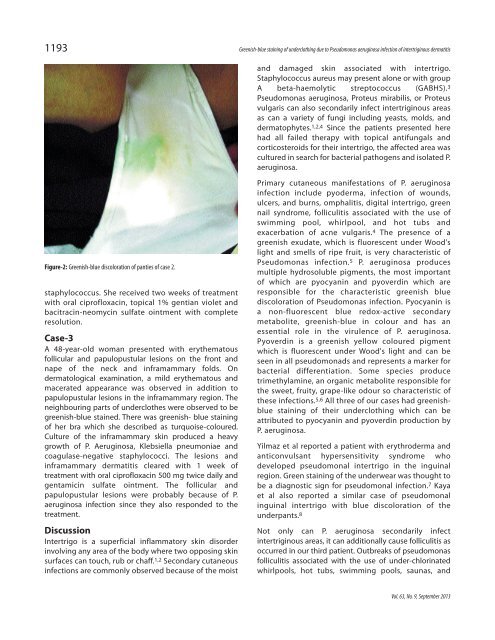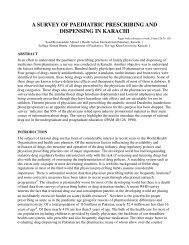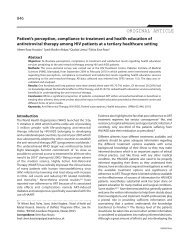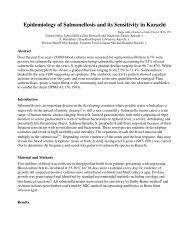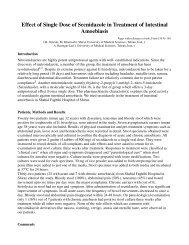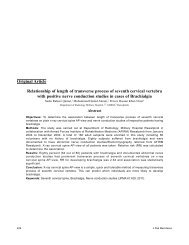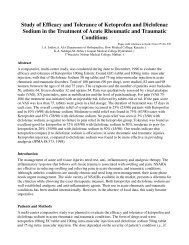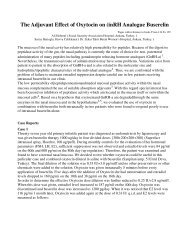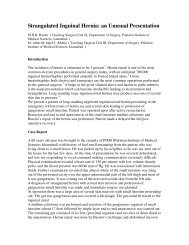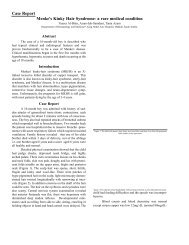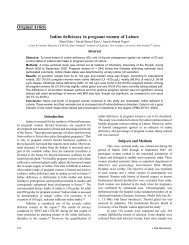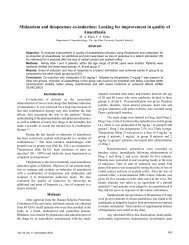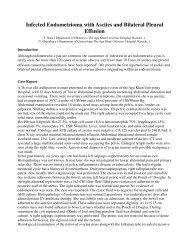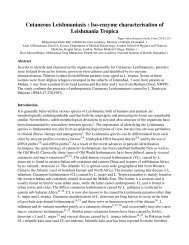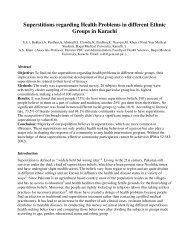Greenish-blue staining of underclothing due to ... - Jpma.org.pk
Greenish-blue staining of underclothing due to ... - Jpma.org.pk
Greenish-blue staining of underclothing due to ... - Jpma.org.pk
Create successful ePaper yourself
Turn your PDF publications into a flip-book with our unique Google optimized e-Paper software.
1193 <strong>Greenish</strong>-<strong>blue</strong> <strong>staining</strong> <strong>of</strong> <strong>underclothing</strong> <strong>due</strong> <strong>to</strong> Pseudomonas aeruginosa infection <strong>of</strong> intertriginous dermatitis<br />
and damaged skin associated with intertrigo.<br />
Staphylococcus aureus may present alone or with group<br />
A beta-haemolytic strep<strong>to</strong>coccus (GABHS). 3<br />
Pseudomonas aeruginosa, Proteus mirabilis, or Proteus<br />
vulgaris can also secondarily infect intertriginous areas<br />
as can a variety <strong>of</strong> fungi including yeasts, molds, and<br />
derma<strong>to</strong>phytes. 1,2,4 Since the patients presented here<br />
had all failed therapy with <strong>to</strong>pical antifungals and<br />
corticosteroids for their intertrigo, the affected area was<br />
cultured in search for bacterial pathogens and isolated P.<br />
aeruginosa.<br />
Figure-2: <strong>Greenish</strong>-<strong>blue</strong> discoloration <strong>of</strong> panties <strong>of</strong> case 2.<br />
staphylococcus. She received two weeks <strong>of</strong> treatment<br />
with oral cipr<strong>of</strong>loxacin, <strong>to</strong>pical 1% gentian violet and<br />
bacitracin-neomycin sulfate ointment with complete<br />
resolution.<br />
Case-3<br />
A 48-year-old woman presented with erythema<strong>to</strong>us<br />
follicular and papulopustular lesions on the front and<br />
nape <strong>of</strong> the neck and inframammary folds. On<br />
derma<strong>to</strong>logical examination, a mild erythema<strong>to</strong>us and<br />
macerated appearance was observed in addition <strong>to</strong><br />
papulopustular lesions in the inframammary region. The<br />
neighbouring parts <strong>of</strong> underclothes were observed <strong>to</strong> be<br />
greenish-<strong>blue</strong> stained. There was greenish- <strong>blue</strong> <strong>staining</strong><br />
<strong>of</strong> her bra which she described as turquoise-coloured.<br />
Culture <strong>of</strong> the inframammary skin produced a heavy<br />
growth <strong>of</strong> P. Aeruginosa, Klebsiella pneumoniae and<br />
coagulase-negative staphylococci. The lesions and<br />
inframammary dermatitis cleared with 1 week <strong>of</strong><br />
treatment with oral cipr<strong>of</strong>loxacin 500 mg twice daily and<br />
gentamicin sulfate ointment. The follicular and<br />
papulopustular lesions were probably because <strong>of</strong> P.<br />
aeruginosa infection since they also responded <strong>to</strong> the<br />
treatment.<br />
Discussion<br />
Intertrigo is a superficial inflamma<strong>to</strong>ry skin disorder<br />
involving any area <strong>of</strong> the body where two opposing skin<br />
surfaces can <strong>to</strong>uch, rub or chaff. 1,2 Secondary cutaneous<br />
infections are commonly observed because <strong>of</strong> the moist<br />
Primary cutaneous manifestations <strong>of</strong> P. aeruginosa<br />
infection include pyoderma, infection <strong>of</strong> wounds,<br />
ulcers, and burns, omphalitis, digital intertrigo, green<br />
nail syndrome, folliculitis associated with the use <strong>of</strong><br />
swimming pool, whirlpool, and hot tubs and<br />
exacerbation <strong>of</strong> acne vulgaris. 4 The presence <strong>of</strong> a<br />
greenish exudate, which is fluorescent under Wood's<br />
light and smells <strong>of</strong> ripe fruit, is very characteristic <strong>of</strong><br />
Pseudomonas infection. 5 P. aeruginosa produces<br />
multiple hydrosoluble pigments, the most important<br />
<strong>of</strong> which are pyocyanin and pyoverdin which are<br />
responsible for the characteristic greenish <strong>blue</strong><br />
discoloration <strong>of</strong> Pseudomonas infection. Pyocyanin is<br />
a non-fluorescent <strong>blue</strong> redox-active secondary<br />
metabolite, greenish-<strong>blue</strong> in colour and has an<br />
essential role in the virulence <strong>of</strong> P. aeruginosa.<br />
Pyoverdin is a greenish yellow coloured pigment<br />
which is fluorescent under Wood's light and can be<br />
seen in all pseudomonads and represents a marker for<br />
bacterial differentiation. Some species produce<br />
trimethylamine, an <strong>org</strong>anic metabolite responsible for<br />
the sweet, fruity, grape-like odour so characteristic <strong>of</strong><br />
these infections. 5,6 All three <strong>of</strong> our cases had greenish<strong>blue</strong><br />
<strong>staining</strong> <strong>of</strong> their <strong>underclothing</strong> which can be<br />
attributed <strong>to</strong> pyocyanin and pyoverdin production by<br />
P. aeruginosa.<br />
Yilmaz et al reported a patient with erythroderma and<br />
anticonvulsant hypersensitivity syndrome who<br />
developed pseudomonal intertrigo in the inguinal<br />
region. Green <strong>staining</strong> <strong>of</strong> the underwear was thought <strong>to</strong><br />
be a diagnostic sign for pseudomonal infection. 7 Kaya<br />
et al also reported a similar case <strong>of</strong> pseudomonal<br />
inguinal intertrigo with <strong>blue</strong> discoloration <strong>of</strong> the<br />
underpants. 8<br />
Not only can P. aeruginosa secondarily infect<br />
intertriginous areas, it can additionally cause folliculitis as<br />
occurred in our third patient. Outbreaks <strong>of</strong> pseudomonas<br />
folliculitis associated with the use <strong>of</strong> under-chlorinated<br />
whirlpools, hot tubs, swimming pools, saunas, and<br />
Vol. 63, No. 9, September 2013


